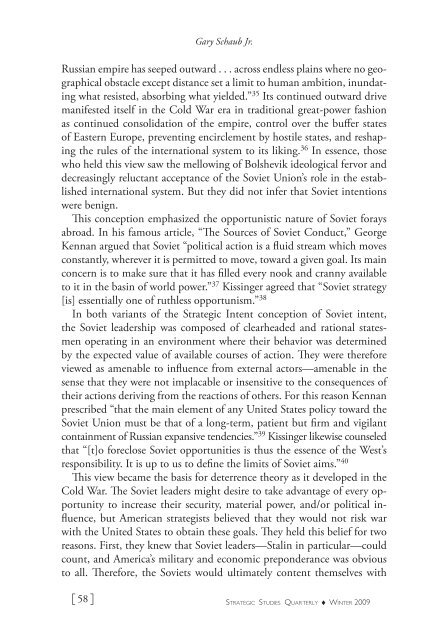When Is Deterrence Necessary? Gauging Adversary Intent
When Is Deterrence Necessary? Gauging Adversary Intent
When Is Deterrence Necessary? Gauging Adversary Intent
You also want an ePaper? Increase the reach of your titles
YUMPU automatically turns print PDFs into web optimized ePapers that Google loves.
Gary Schaub Jr.<br />
Russian empire has seeped outward . . . across endless plains where no geographical<br />
obstacle except distance set a limit to human ambition, inundating<br />
what resisted, absorbing what yielded.” 35 Its continued outward drive<br />
manifested itself in the Cold War era in traditional great-power fashion<br />
as continued consolidation of the empire, control over the buffer states<br />
of Eastern Europe, preventing encirclement by hostile states, and reshaping<br />
the rules of the international system to its liking. 36 In essence, those<br />
who held this view saw the mellowing of Bolshevik ideological fervor and<br />
decreasingly reluctant acceptance of the Soviet Union’s role in the established<br />
international system. But they did not infer that Soviet intentions<br />
were benign.<br />
This conception emphasized the opportunistic nature of Soviet forays<br />
abroad. In his famous article, “The Sources of Soviet Conduct,” George<br />
Kennan argued that Soviet “political action is a fluid stream which moves<br />
constantly, wherever it is permitted to move, toward a given goal. Its main<br />
concern is to make sure that it has filled every nook and cranny available<br />
to it in the basin of world power.” 37 Kissinger agreed that “Soviet strategy<br />
[is] essentially one of ruthless opportunism.” 38<br />
In both variants of the Strategic <strong>Intent</strong> conception of Soviet intent,<br />
the Soviet leadership was composed of clearheaded and rational statesmen<br />
operating in an environment where their behavior was determined<br />
by the expected value of available courses of action. They were therefore<br />
viewed as amenable to influence from external actors—amenable in the<br />
sense that they were not implacable or insensitive to the consequences of<br />
their actions deriving from the reactions of others. For this reason Kennan<br />
prescribed “that the main element of any United States policy toward the<br />
Soviet Union must be that of a long-term, patient but firm and vigilant<br />
containment of Russian expansive tendencies.” 39 Kissinger likewise counseled<br />
that “[t]o foreclose Soviet opportunities is thus the essence of the West’s<br />
responsibility. It is up to us to define the limits of Soviet aims.” 40<br />
This view became the basis for deterrence theory as it developed in the<br />
Cold War. The Soviet leaders might desire to take advantage of every opportunity<br />
to increase their security, material power, and/or political influence,<br />
but American strategists believed that they would not risk war<br />
with the United States to obtain these goals. They held this belief for two<br />
reasons. First, they knew that Soviet leaders—Stalin in particular—could<br />
count, and America’s military and economic preponderance was obvious<br />
to all. Therefore, the Soviets would ultimately content themselves with<br />
[ 58 ]<br />
Strategic Studies Quarterly ♦ Winter 2009
















